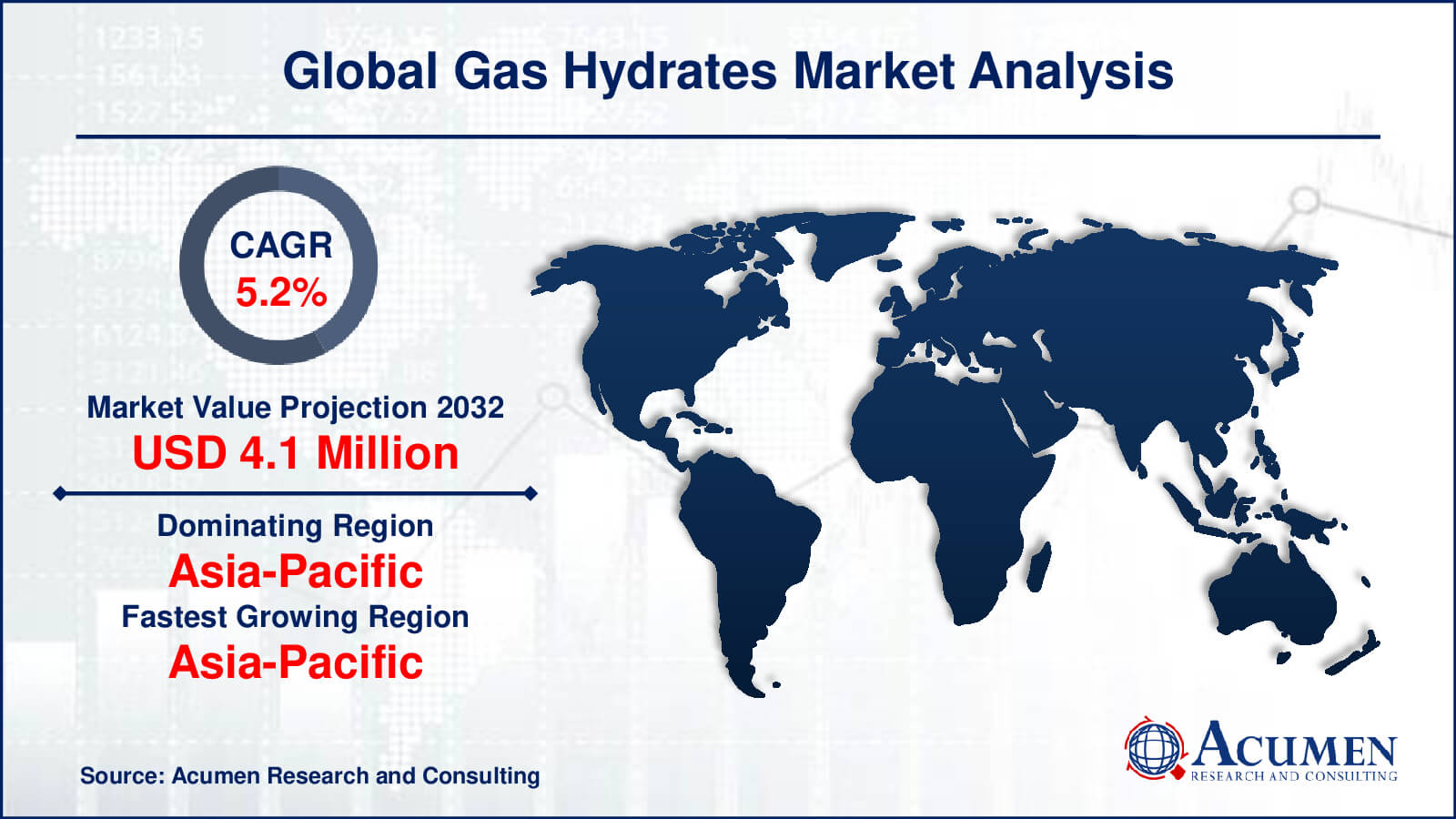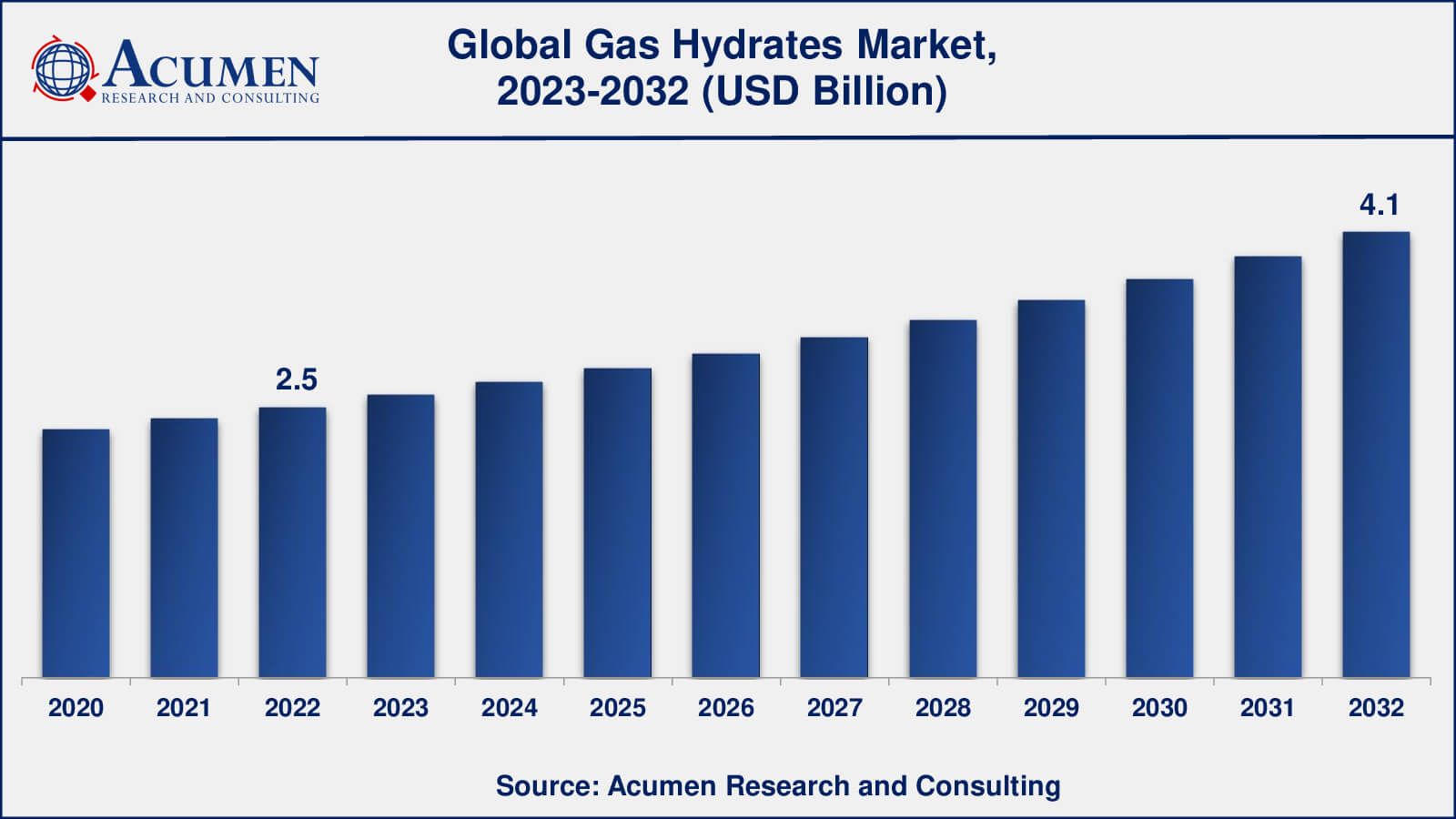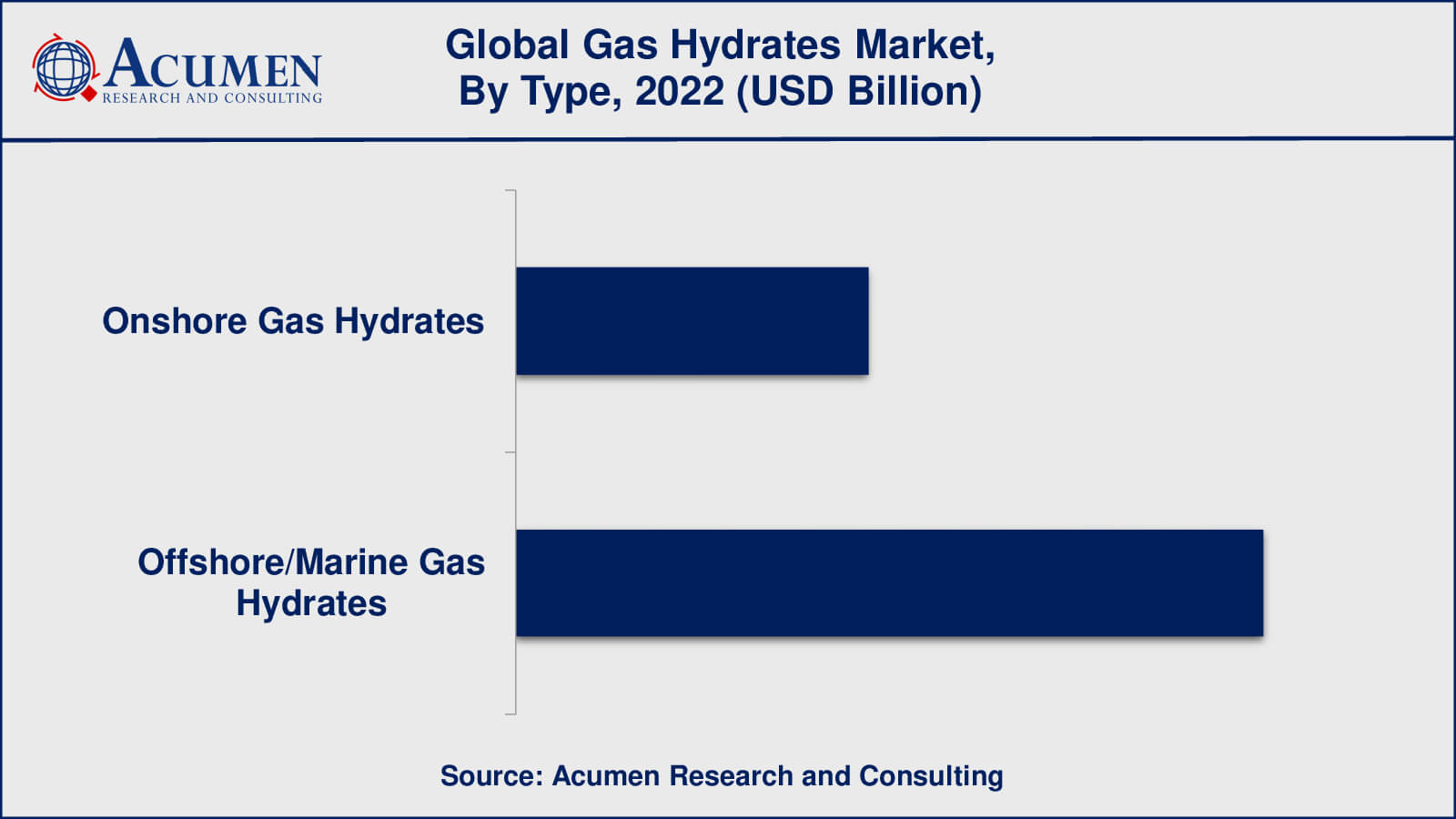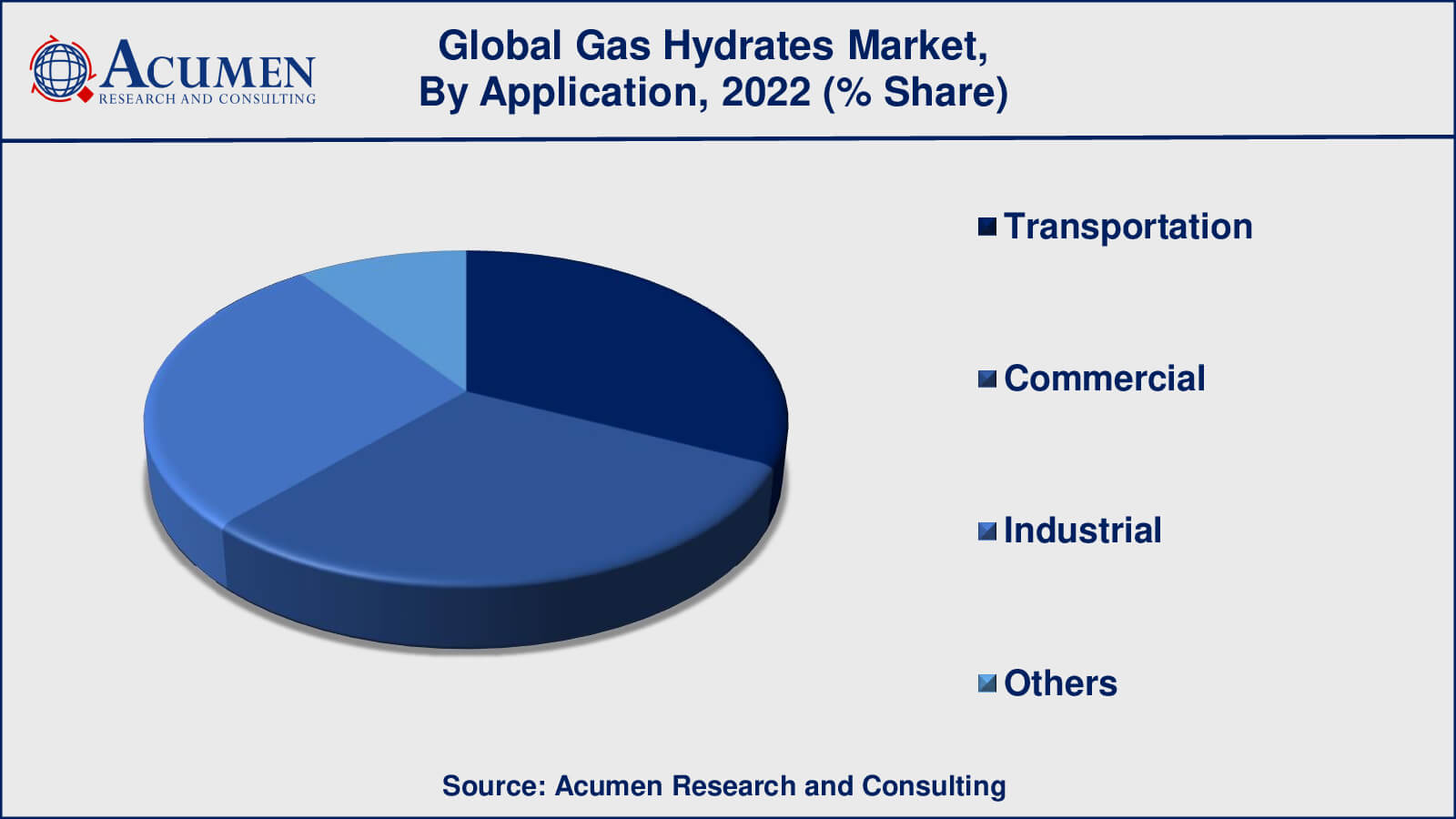April 2024
Gas Hydrates Market size was valued at USD 2.5 Billion in 2022 and is projected to attain USD 4.1 Billion by 2032 mounting at a CAGR of 5.2% from 2023 to 2032.
The global Gas Hydrates Market size was valued at USD 2.5 Billion in 2022 and is projected to attain USD 4.1 Billion by 2032 mounting at a CAGR of 5.2% from 2023 to 2032.
Gas Hydrates Market Highlights

Gas hydrates are crystalline substances generated under specified temperature and pressure circumstances from water molecules and gas molecules, often methane. These intricate formations are reminiscent of ice, with gas molecules trapped within a lattice-like network of water molecules. The resultant solid material is extremely stable in deep ocean sediments and permafrost locations. Gas hydrates may be found in both marine and terrestrial settings, and are frequently buried behind layers of sediment.
These compounds are of great scientific and economic interest because to their immense potential as an energy resource and their involvement in the Earth's carbon cycle. Massive amounts of methane are trapped in gas hydrates across the planet, significantly exceeding conventional natural gas reserves. Exploring these alternative energy sources becomes more appealing as global energy demand rises and concerns about climate change grow.

Global Gas Hydrates Market Dynamics
Market Drivers
Market Restraints
Market Opportunities
Gas Hydrates Market Report Coverage
| Market | Gas Hydrates Market |
| Gas Hydrates Market Size 2022 | USD 2.5 Billion |
| Gas Hydrates Market Forecast 2032 | USD 4.1 Billion |
| Gas Hydrates Market CAGR During 2023 - 2032 | 5.2% |
| Gas Hydrates Market Analysis Period | 2020 - 2032 |
| Gas Hydrates Market Base Year | 2022 |
| Gas Hydrates Market Forecast Data | 2023 - 2032 |
| Segments Covered | By Type, By Origin, By Application, And By Geography |
| Regional Scope | North America, Europe, Asia Pacific, Latin America, and Middle East & Africa |
| Key Companies Profiled | BP plc, Chevron Corporation, China National Offshore Oil Corporation (CNOOC), ConocoPhillips, ExxonMobil Corporation, Gazprom, Japan Oil, Gas and Metals National Corporation (JOGMEC), Korea Gas Corporation (KOGAS), PetroChina Company Limited, Shell Global, Statoil (Equinor), and TotalEnergies SE. |
| Report Coverage |
Market Trends, Drivers, Restraints, Competitive Analysis, Player Profiling, Covid-19 Analysis, Regulation Analysis |
Gas Hydrates Market Insights
The gas hydrates market is characterized by a dynamic interaction of numerous elements that affect its development. The enormous energy resource potential that facilitates the diversification of energy portfolios is a critical driver in this sector. As traditional fossil fuels face scrutiny for their environmental effect, energy source diversification becomes critical, sparking interest in unconventional solutions such as petrol hydrates. This urge is pushed further by technology breakthroughs that have permitted more effective and practical extraction methods, allowing access to hitherto untapped energy supplies.
Simultaneously, the relevance of petrol hydrates is heightened by the urgency of climate change mitigation. These chemicals provide a unique potential to improve environmental responsibility by trapping methane within the hydrates. The ability to keep methane, a strong greenhouse gas, from entering the environment fits with worldwide efforts to reduce emissions and combat climate change. Furthermore, as global energy demand rises, the research of unconventional energy sources such as petrol hydrates becomes necessary to fulfill the rising demand.
However, the market for petrol hydrates is not without its difficulties. The severe conditions and complicated reservoirs where gas hydrates are located provide technical challenges in extraction. These difficulties necessitate creative technical solutions to assure safe and effective extraction. Concerns regarding possible methane escapes during extraction, as well as their influence on ecosystems, are potentially important impediments. Furthermore, high extraction costs pose economic obstacles, limiting the widespread acceptance and commercial feasibility of petrol hydrates as an energy resource.
The absence of transportation and processing facilities further restricts the growth of the petrol hydrates industry. Adequate infrastructure is required for efficient and cost-effective gas hydrate extraction, transportation, and utilization. Furthermore, the unpredictability of gas hydrate reservoir behavior hinders correct resource evaluation and management, adding uncertainties that must be addressed in order to make educated decisions.
Among these problems are significant opportunities. Innovative extraction technologies are emerging as critical facilitators of safer, more efficient manufacturing processes. Furthermore, the possibility of carbon capture and storage provides a compelling route for harnessing petrol hydrates in emissions reduction measures and enhancing sustainability efforts. Prospects for energy commerce develop when nations with major gas hydrate deposits become energy exporters, changing geopolitical dynamics. Deeper insights into the behavior and uses of gas hydrates are being gained via research and collaboration in the field, and their incorporation into the sustainable energy mix coincides with global environmental goals.
Gas Hydrates Market Segmentation
The worldwide market for gas hydrates is split based on type, origin, application, and geography.
Gas Hydrates Types

As per the gas hydrates industry analysis, the offshore gas hydrates sub-segment generated the utmost revenue in 2022. Offshore gas hydrates are the occurrence of gas hydrate deposits beneath the seabed in maritime settings. At appropriate temperature and pressure circumstances, these deposits occur when gas molecules, often methane, become trapped within a lattice-like structure of water molecules. Offshore gas hydrates are found in sediments of continental shelves, slopes, and deep-sea zones, which are frequently located in cold and high-pressure ocean environments.
Offshore gas hydrates are an important energy resource that have the potential to contribute to the global energy mix. Their exploration, extraction, and commercialization, on the other hand, present severe technological, environmental, and economic hurdles. The importance of offshore gas hydrates in the energy landscape may become apparent as technology progresses and energy demands change. Onshore gas hydrates also have potential, especially in areas where permafrost regions exist.
Gas Hydrates Origins
Gas hydrates found on the seabed, particularly in deep-sea sediments, have attracted considerable attention due to their vast reserves and potential as an energy source. The continental shelves and slopes of oceans hold substantial amounts of gas hydrates. These hydrates are often located in cold and high-pressure environments, making their extraction challenging but potentially rewarding.
Gas hydrates present in permafrost regions, including Arctic and subarctic areas, are another important origin segment. Permafrost regions contain significant methane hydrate deposits beneath frozen ground. These deposits can be located both onshore and offshore in shallow waters.
Gas Hydrates Applications

According to the gas hydrates market forecast, trasportation application is expected to lead the market from 2023 to 2032. The potential use of gas hydrates for natural gas storage and transportation has piqued the interest of researchers. Gas hydrates might provide an effective solution to store and transport natural gas, which could be especially useful in areas where traditional gas transportation infrastructure is inadequate.
Gas hydrates have the potential to be used in a variety of commercial and industrial applications. Among these include exploiting hydrates as a feedstock for chemical operations, gas separation, and as a platform for carbon capture and storage to reduce greenhouse gas emissions.
The "others" category includes a wide range of prospective uses, including as exploiting petrol hydrates for research, resolving environmental concerns about methane emissions, and even investigating their possibilities in new and developing technologies.
Gas Hydrates Market Regional Segmentation
North America
Europe
Asia-Pacific
Latin America
The Middle East & Africa
Gas Hydrates Market Regional Analysis
The Arctic has been a focal point for gas hydrate research and exploration due to its abundance of hydrate resources in permafrost and marine environments. Countries possessing Arctic regions, including as Russia, Canada, and the United States, have performed substantial research and exploratory drilling. In this location, the potential for energy growth and the environmental difficulties of methane emission are important factors. Both the United States and Canada have been interested in gas hydrate research and exploration, particularly in their Arctic and offshore regions. The occurrence of hydrates in northern Alaska and along the United States' continental slopes increases their strategic significance.
Countries like as Japan and South Korea have invested in gas hydrate research and development. Japan, for example, has started on extensive offshore exploration initiatives. Energy demand, technological competence, and proximity to hydrate-rich areas all contribute to the region's commercial importance. Furthermore, gas hydrate research has piqued the interest of European countries such as Norway, notably as a potential energy resource. Norway's technological capabilities in offshore drilling and energy innovation qualify it to participate in the gas hydrates market.
Gas Hydrates Market Players
Some of the top gas hydrates companies offered in our report includes BP plc, Chevron Corporation, China National Offshore Oil Corporation (CNOOC), ConocoPhillips, ExxonMobil Corporation, Gazprom, Japan Oil, Gas and Metals National Corporation (JOGMEC), Korea Gas Corporation (KOGAS), PetroChina Company Limited, Shell Global, Statoil (Equinor), and TotalEnergies SE.
Looking for discounts, bulk pricing, or custom solutions? Contact us today at sales@acumenresearchandconsulting.com
April 2024
May 2025
December 2023
July 2024